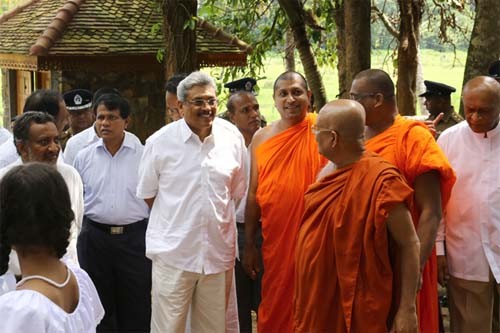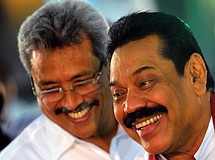Internal change is the best and maybe only hope
“The government’s strength as a political force is that it has within itself all shades of political opinion from within the ethnic majority Sinhalese community. It is dominated by leaders who hold to nationalist positions, but it also has the religious extremists, liberals and leftists within its ranks. The government has also been able to induce some of the ethnic minority leaders to be part of their alliance. They are bound together by their common self-interest in remaining in power. As a result it can be said that the government is broadly reflective of the political pluralism within the country. But while it is reflective it is not really representative of the pluralism within the population, who appear to be less nationalist than the dominant government leadership.”
government alliance itself. Most if not nearly all of the incidents of election-related violence being reported by election monitors are intra-party ones. It appears that the government candidates see each other as being the bigger threat to their personal victories rather than the opposition parties. This also indicates how marginalized the opposition parties continue to be in the larger part of the country in the face of the government juggernaut.
The situation in the Northern Province is different. There are no reports of election-related violence at the present time. Instead there are allegations of efforts by candidates of the government alliance to provide material incentives to the people in the form of promises of employment and economic development. A unique feature of the run-up to elections in the North is the activity of the government’s intelligence services who are busily, and visibly, involving themselves by checking on the backgrounds of the prospective candidates belonging to the opposition.
It appears that the government is aware that it cannot win the provincial elections in the North. This accounts for the difference between the behavior of the government candidates in the Northern Province and in the other two provinces. In the Northern Province, the government candidates are aware that they will not be able to hold elected office whatever they may do. On the other hand, in the Sinhalese-dominated provinces the government candidates feel that they are assured of victory. Therefore the government candidates compete against each other to obtain the important positions of office after the elections.
GOVERNMENT’S STRENGTH
The government’s strength as a political force is that it has within itself all shades of political opinion from within the ethnic majority Sinhalese community. It is dominated by leaders who hold to nationalist positions, but it also
has the religious extremists, liberals and leftists within its ranks. The government has also been able to induce some of the ethnic minority leaders to be part of their alliance. They are bound together by their common self-interest in remaining in power. As a result it can be said that the government is broadly reflective of the political pluralism within the country. But while it is reflective it is not really representative of the pluralism within the population, who appear to be less nationalist than the dominant government leadership.
A fruit salad government
It was in this context that a participant at a conference held last week on the role of the Report of the Lessons Learnt and Reconciliation Commission in the healing and reconciliation process in the country assessed the government to be “like a fruit salad.” The analogy of a fruit salad, in which a person can pick and choose the fruit to eat, and not to eat, was the one that the participant was contemplating. He was reflecting upon the controversy about the implementation of the LLRC recommendations within the country. The government claims to be implementing it. But when seminars are held at the district level most government officials know next to nothing about it.
Major roles
The opening speech at the conference by Minister of National Languages and Social Integration Vasudeva Nanayakkara justified the use of this fruit salad analogy at the conference, organized by Voluntary Service Overseas (VSO) which was meant to discuss the findings of an educational project on the recommendations of the Lessons Learnt and Reconciliation Commission. Three Sri Lankan organisastions, Peace and Community Action, National Peace Council and Jaffna Social Action Committee played major roles in the conducting of the workshops in six districts of the country, which were Ampara, Batticaloa, Jaffna, Matara, Puttalam and Trincomalee.
SUPPORTIVE MINISTER
Delivering the opening speech at the conference, Minister Nanayakkara spoke of the multiple initiatives of his
ministry to implement the LLRC recommendations that fell within his purview. These included training of public officials in language competency, ensuring the presence of Tamil-speaking officials in all government departments that dealt with the general public, setting up language committees to mobilize people to be bilingual and also ensuring that all name boards on roads, government offices and buses were in all three languages. Minister Nanayakkara also spoke supportively of the importance of the LLRC recommendations and the role of civil society in creating awareness of them amongst the general population and in implementing relevant recommendations.
The presence of a government minister at this civil society event was a great reassurance to the participants, especially those who came from the North and East, who are more accustomed to government strictures and controls than support. One notable feature of the day’s proceedings was the singing of the national anthem. Minister Nanayakkara’s effort to persuade the government to come up with a national policy on singing the national anthem in both languages has so far not been successful. The ignorance shown by some government ministers of international practice in this regard has been abysmal, with ministerial claims that no country in the world sings its national anthem in more than one language, which is patently untrue.
The LLRC has recommended that the national language should be sung in both languages. The constitution has the national anthem in both the Sinhala and Tamil languages as the constitution is available in its entirety in both the
official languages. However, after the war a problem arose in the North of the country where the military began to show hostility towards the singing of the national anthem in the Tamil language as had been the practice. As a result there is uncertainty in the country whether the national language can indeed be sung in the Tamil language. However, along with the rest of the participants at the conference, the Minister stood to attention when the national anthem was sung in both languages in accordance with the LLRC recommendations.
The purpose of the conference was to get a consensus on the priorities of the people in relation to the LLRC recommendations and to identify the actions that civil society and local government could take to implement them. The positive tenor set by the opening ceremony at the conference, the Minister’s speech and the singing of the national language in both languages, was to continue to the close of the conference. There was a recognition that Sinhalese, Tamils and Muslims thought similarly on many issues. There was agreement to issue a statement setting out what the people’s priorities for reconciliation were and to sign the document with their individual names.
DIFFERENT REALITY
Unfortunately, the ground situation in the country in regard to governmental action is very different. The reality is that Minister Nanayakkara, who is supportive of civil society and minority rights, is one minister among a hundred plus. One participant at the conference from Ampara in the east said that the people there had been made to believe that the LLRC report was an LTTE-inspired document which was anti-government. This view was echoed by a participant from Puttalam on the west coast who said that he had a similar experience when he tried to organize a discussion on the LLRC in his village. A participant from Trincomalee said that people in Sampur who lost their lands due to a power generation project continue to live in huts and on one meal a day. Although the government had arrested the suspects in the killings of five students in Trincomalee during the war years, no one was prepared to give evidence for fear of their lives.
The legacy of the three decade long war continues to haunt Sri Lanka. There is still little in the government’s fruit salad for people to nourish the spirit of reconciliation that will unify the country. The peace dividend that was anticipated in the sense of a country that belongs to all, and in which all communities contribute to decision-making, has yet to materialize. Suspicions are rife, alienation remains and new divisions have arisen. Although the country is united in territory it has become increasingly polarized in heart and mind in a manner that was not anticipated, notwithstanding signs of material progress epitomized in major infrastructural development. It is not enough to build roads for rapid movement and to teach languages so that people can understand each other. There is also a need to implement the rest of the LLRC recommendations, and for the government officials to know what the LLRC is about.
However, there is hardly anything the government is doing to educate the people about the LLRC and its recommendations. The LLRC document is not even printed for mass circulation, but is only accessible on the government’s website. The government’s lack of interest in promoting awareness of the LLRC amongst its own public officials, let alone the general public, means that the vast majority of people in the country will continue to be vulnerable to the propaganda of nationalist and extremist politicians who dominate the government decision-making processes. In this scenario, the possibility of fundamental political change is remote. There appears to be no political alternative to the current government leadership that has an equivalent financial, military and media strength behind it. Therefore the best hope of change is that an internal change of heart within the government leadership will occur.



